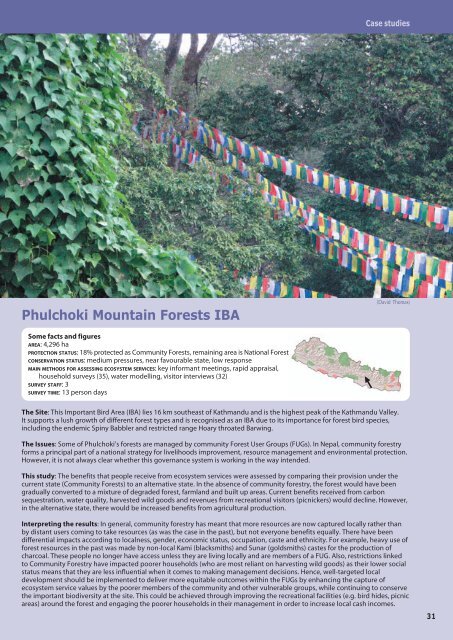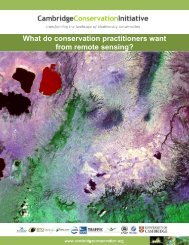CONSERVING BIODIVERSITY & DELIVERING ECOSYSTEM SERVICES
conserving biodiversity & delivering ecosystem services
conserving biodiversity & delivering ecosystem services
Create successful ePaper yourself
Turn your PDF publications into a flip-book with our unique Google optimized e-Paper software.
(David Thomas)<br />
Some facts and figures<br />
AREA: 4,296 ha<br />
PROTECTION STATUS: 18% protected as Community Forests, remaining area is National Forest<br />
CONSERVATION STATUS: medium pressures, near favourable state, low response<br />
MAIN METHODS FOR ASSESSING <strong>ECOSYSTEM</strong> <strong>SERVICES</strong>: key informant meetings, rapid appraisal,<br />
household surveys (35), water modelling, visitor interviews (32)<br />
SURVEY STAFF: 3<br />
SURVEY TIME: 13 person days<br />
The Site: This Important Bird Area (IBA) lies 16 km southeast of Kathmandu and is the highest peak of the Kathmandu Valley.<br />
It supports a lush growth of different forest types and is recognised as an IBA due to its importance for forest bird species,<br />
including the endemic Spiny Babbler and restricted range Hoary throated Barwing.<br />
The Issues: Some of Phulchoki’s forests are managed by community Forest User Groups (FUGs). In Nepal, community forestry<br />
forms a principal part of a national strategy for livelihoods improvement, resource management and environmental protection.<br />
However, it is not always clear whether this governance system is working in the way intended.<br />
This study: The benefits that people receive from ecosystem services were assessed by comparing their provision under the<br />
current state (Community Forests) to an alternative state. In the absence of community forestry, the forest would have been<br />
gradually converted to a mixture of degraded forest, farmland and built up areas. Current benefits received from carbon<br />
sequestration, water quality, harvested wild goods and revenues from recreational visitors (picnickers) would decline. However,<br />
in the alternative state, there would be increased benefits from agricultural production.<br />
Interpreting the results: In general, community forestry has meant that more resources are now captured locally rather than<br />
by distant users coming to take resources (as was the case in the past), but not everyone benefits equally. There have been<br />
differential impacts according to localness, gender, economic status, occupation, caste and ethnicity. For example, heavy use of<br />
forest resources in the past was made by non-local Kami (blacksmiths) and Sunar (goldsmiths) castes for the production of<br />
charcoal. These people no longer have access unless they are living locally and are members of a FUG. Also, restrictions linked<br />
to Community Forestry have impacted poorer households (who are most reliant on harvesting wild goods) as their lower social<br />
status means that they are less influential when it comes to making management decisions. Hence, well-targeted local<br />
development should be implemented to deliver more equitable outcomes within the FUGs by enhancing the capture of<br />
ecosystem service values by the poorer members of the community and other vulnerable groups, while continuing to conserve<br />
the important biodiversity at the site. This could be achieved through improving the recreational facilities (e.g. bird hides, picnic<br />
areas) around the forest and engaging the poorer households in their management in order to increase local cash incomes.




